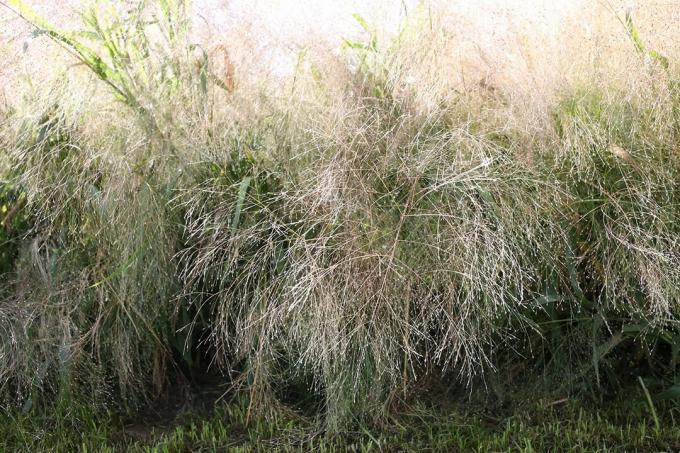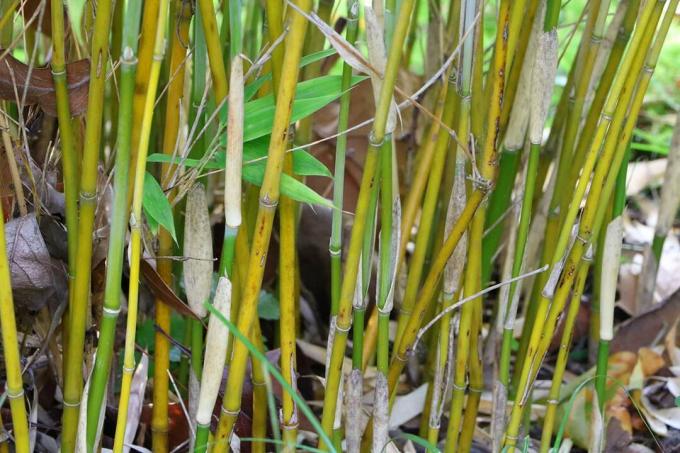

Table of contents
- Characteristics
- location and soil
- planting time
- plants and plant spacing
- Pour
- Fertilize
- Cut
- hibernate
- multiply
- Use and plant neighbors
- Bucket attitude
- diseases and pests
In late summer, when the narrow stalks of switchgrass bend under the pretty spikes of flowers, the ornamental grass is an attractive sight. Read our guide to find out how best to plant and care for Panicum virgatum.
Characteristics
- Origin: North America
- Use: easy-care ornamental grass in different varieties and colors
- Growth height: between 60 centimeters and two meters
- Growth width: up to one meter
- Growth: clump-forming, upright
- Flowers: panicles of brown flowers between July and September
- Leaves: narrow, autumn colour
- Recommended varieties: 'Rehbraun' (reddish brown in autumn), 'Hänse Herms' (bright red), 'Northwind' (yellow autumn colour), 'Heavy Metal' (bluish), 'Strictum' (bright yellow)
location and soil
It is best to plant the switchgrass in full sun with loose, well-drained and humus-rich soil. Like all grasses, Panicum virgatum does not tolerate waterlogging, which is why heavy, loamy soil is unsuitable. However, you can improve it if necessary:
- Dig at least 15 centimeters deep
- Create drainage from pebbles and sand
- fill with humus soil
Light sandy soils, on the other hand, should be enriched with nutrient-rich humus soil, as the grass has a high nutrient requirement. Half-shady or shady locations are too dark and therefore unsuitable, the plant will not form flowers here.
planting time
The best planting time is spring, as soon as the sun has developed sufficient strength and the ground has thawed. Now you can plant the robust Panicum from March, whereby the soil should be kept slightly moist in the first few weeks after planting. If it is damp and warm enough, switchgrass grows very quickly and develops many strong stalks. In principle, however, planting is possible throughout the summer until October.
plants and plant spacing
And this is how the uncomplicated switchgrass is best planted:
- Dig a planting hole
- Optimal size: twice the size of the root ball
- Loosen the bottom of the perforated well
- if necessary, fill in drainage (e.g. B. Sand)
- Mix excavation with mature compost
- alternatively good hummus or purchased compost
- insert plant
- not too deep: should be flush with the ground, just like in the planter
- trample earth
- pour vigorously
When planting in a group, we recommend a distance of approx. 30 to 50 centimeters, with a solitary plant you can leave a little more space between the clumps.

Tip:
Mulch the root area, for example with gravel or bark mulch. This not only prevents the soil from drying out, but also prevents annoying weeds from growing.
Pour
When it comes to watering, Panicum virgatum is a bit tricky: it is particularly important in the first few weeks after planting and during the hot and dry summer months, an even water supply is necessary, but the roots must not be too wet stand.
- water regularly but moderately in the first two years after planting
- Just keep the soil slightly moist
- important for rooting and establishing at the new location
- Moisture ensures vigorous root growth
- in later years only water on sunny, hot days or in very dry weather periods
Since the amount of water depends on individual parameters such as location, soil conditions, temperature and size of the plant, no precise information can be given about the optimal amount of water. If in doubt, it is better to keep the clumps dry than moist, since switchgrass is much less sensitive to drought. As long as the stems make a vital impression, the plant is properly cared for. However, if Panicum lets them hang limp on a sunny day, you should check the soil moisture, for example by finger testing, and adjust your watering habits.
Fertilize
Switchgrass planted in the garden is fertilized twice a year, for which organic fertilizers such as compost or a commercially available bamboo fertilizer are best suited. Alternatively, you can also use an organic organic garden fertilizer. The first fertilization takes place with the spring shoots and is intended to strengthen the plant for vigorous growth.
- one shovel full of ripe compost per nest
- distribute in the root area
- work lightly into the soil
- Dose purchased fertilizer according to package instructions
- always water afterwards
The second fertilization takes place between mid-June and the beginning of July and has the task of replenishing exhausted nutrient reserves and preparing the eyrie for the coming winter. In addition to the autumn colors, flowering only begins when there is a sufficient supply of nutrients.
Tip:
Homemade nettle manure mixed with rainwater and a handful of rock flour in a ratio of 1:9 results in a valuable liquid plant fertilizer.
Cut
Although the stalks dry up in autumn, they should remain on the plant during the winter months as a natural protection against the cold. Only in early spring cut off the previous year's stalks close to the ground to make room for the new shoots. This cut is best carried out on a dry and frost-free day in March or April.
hibernate
Because Panicum virgatum is very hardy, you don't need to take any special precautions. A light winter protection in the form of brushwood, leaves or compost only makes sense for young plants that have been in their location for less than two years. You do not need to cover the dry stalks, instead the cold protection is only applied to the root area. The layer should be about two inches thick.
multiply
The simplest way of propagation is division, in which you get several smaller plants from a clump. The best way to do this is as follows:
- best time: spring
- Cut dry stems close to the ground
- Dig out the clump together with the roots
- Use digging fork
- Divide the rootstock into several pieces with a spade
- Replant pieces one at a time
Tip:
You do not necessarily have to dig up very large clumps of grass, you can simply cut off the outer parts of these with a sharp spade and plant them in the garden as new plants.

Use and plant neighbors
Panicum cuts a fine figure both individually and in a group planting. The taller varieties, such as 'Strictum' or 'Cloud Nine', are also very suitable as privacy screens, for example to protect the terrace from prying eyes. Otherwise, the grass harmonises very well with other late-blooming perennials that have similar location preferences. Switchgrass is particularly effective with species such as
- Purple Coneflower (Echinacea purpurea)
- barbel (Penstemon barbatus)
- Autumn Asters (Aster dumosus)
- Phlox / Phlox (Phlox paniculata)
- Stonecrop/stonecrop (sedum)
- blaze (Liatris spicata)
- Candelabra Prize of Honor (Veronicastrum virginicum)
- Blue rhombus/ silver bush (Perovskia atriplicifolia)
In addition, a socialization with other grasses that feel comfortable in dry sunny places is possible. Suitable for this
- Blue Ray Oats (Helictotrichon sempervirens)
- blue fescue (Festuca glauca)
- rainbow fescue (Festuca amethystina)
- moor grass (Molinia arundinacea)
- Pennisetum grass (Pennisetum alopecuroides)
- Heron Feather Grass (Stipa pulcherrima)
In addition to the plant species mentioned, variegated shrubs such as the bladder spire also fit (Physocarpus opulifolius) or the smoke bush (Cotinus coggygria) harmoniously in a bed with Panicum virgatum.
Tip:
A picturesque autumn bed is created from various grasses, autumn asters and sedum.
Bucket attitude
Lower Panicum varieties can be cultivated in tubs, as long as there is good drainage in the planter. This should definitely have a drainage hole on the bottom and stand in a planter or in a bowl so that excess water can be removed immediately. You should also fill the bottom of the pot with a drainage layer of potsherds or expanded clay that is two to five centimeters thick, depending on the size of the pot. Only then does the loose, nutrient-rich humus or compost soil.
In contrast to planted switchgrass, specimens cultivated in tubs should be kept evenly moist and supplied with a long-term fertilizer in spring. These care instructions will also help:
- repot annually in fresh substrate
- choose a larger pot if necessary
- preferably made of natural material such as ceramics or clay
- Avoid plastic because of heat development
- wrap in jute or fleece in winter
- occasional watering even in winter
You can plant the switchgrass individually, but also together with other species in a larger container. Here you should definitely keep to the recommended planting distance. Low varieties such as 'Rehbraun', 'Hänse Herms' or 'Shenandoah' are ideal for keeping in buckets.
diseases and pests
Switchgrass is very robust and not very susceptible to pest infestation or diseases. Problems usually only arise because the wrong location was chosen or the plant was kept too moist. You can recognize the latter by the leaf tips that initially turn yellowish, which later turn black and die off. On the other hand, in locations that are too dark, there are no flowers and only a few new shoots.
 garden editorial
garden editorial I write about everything that interests me in my garden.
Learn more about ornamental grasses

cutting bamboo | When and how to cut back bamboo?
Be it as a hedge, solitaire or ground cover, bamboo can be seen more and more often in home gardens. Because the sweet grass is easy to care for and easy to grow. However, the latter can quickly become a problem if the plants are not pruned regularly.

11 Tips for Cutting Grasses | Tools & Co.
Cutting ornamental grass works best with our tips: From choosing the right tool to right time - we have the most useful tips and tricks for you for the annual grass cut summarized.

Zebra grass, Miscanthus sinensis 'Strictus': Care from A - Z
In botanical jargon, zebra grass is also called Miscanthus sinensis 'Strictus'. The plants can be used wonderfully as privacy screens and are decorative. From care in the tub to overwintering: You can find information on care from A - Z here.

Grow pampas grass from seeds: we explain how
Pampas grass is considered easy to cultivate and can be successfully propagated by breeding. Under controlled conditions in the planter, the germination success is higher than with direct outdoor sowing. The procedures regarding substrate, choice of location and care hardly differ in these variants.

Grasses as a privacy screen: 20 tall grasses
Numerous grasses are ideal as privacy screens! We present the 20 most popular grasses in this article!

Grasses for the balcony | 21 hardy ornamental grasses
Grasses are comparatively easy-care and undemanding plants that can also be suitable for the balcony. But which ornamental grasses are these and which hardy species are available? Our overview will help.
